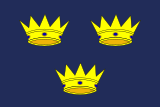
Back An Mhumhain AN مونستر (محافظة أيرلندية) Arabic Munster AST Munster (Irland) BAR Манстэр Byelorussian Манстэр BE-X-OLD Мънстър Bulgarian Cúige Mumhan Breton Munster Catalan Munster (lalawigan) CEB
Munster
An Mhumhain[1] | |
|---|---|
 | |
| Coordinates: 52°15′N 9°00′W / 52.250°N 9.000°W | |
| State | Ireland |
| Counties | Clare Cork Kerry Limerick Tipperary Waterford |
| Government | |
| • Teachtaí Dála | 13 Fianna Fáil TDs 8 Independent TDs 8 Sinn Féin TDs 8 Fine Gael TDs 2 Labour Party TDs 2 Green Party TDs 1 Anti-Austerity Alliance TD 1 Social Democrat TD |
| • MEPs[a] | 1 Fine Gael MEP 2 Fianna Fáil MEP 1 Sinn Fein MEP 1 Independent MEP |
| Area | |
| • Total | 24,684 km2 (9,527 sq mi) |
| • Rank | 1st |
| Population (2022)[2] | |
| • Total | 1,373,346 |
| • Rank | 3rd |
| • Density | 56/km2 (140/sq mi) |
| Time zone | UTC±0 (WET) |
| • Summer (DST) | UTC+1 (IST) |
| Eircode routing keys | Beginning with E, H, P, T, V, X (primarily) |
| Telephone area codes | 02x, 05x, 06x (primarily) |
| ISO 3166 code | IE-M |
| Patron Saint: Ailbe of Emly[3] a. ^ Munster is part of the South constituency; the six Munster counties contain 67.7% of the population of this constituency.[4] | |
Munster (Irish: an Mhumhain [ə ˈwuːnʲ] or Cúige Mumhan [ˌkuːɟə ˈmˠuːnˠ]) is one of the four provinces of Ireland, located in the south of the island. In early Ireland, the Kingdom of Munster was one of the kingdoms of Gaelic Ireland ruled by a "king of over-kings" (Irish: rí ruirech). Following the Norman invasion of Ireland, the ancient kingdoms were shired into counties for administrative and judicial purposes. In later centuries, local government legislation has seen further sub-division of the historic counties.
Munster has no official function for local government purposes. For the purposes of the ISO, the province is listed as one of the provincial sub-divisions of the State (ISO 3166-2:IE) and coded as "IE-M". Geographically, Munster covers a total area of 24,675 km2 (9,527 sq mi) and has a population of 1,373,346,[2] with the most populated city being Cork. Other significant urban centres in the province include Limerick and Waterford.
- ^ "ISO 3166-2 Newsletter II-1, 19 February 2010, which gives Munster as the official English name of the Province and An Mhumhain as the official Irish name of the Province and cites "Ordnance Survey Office, Dublin 1993" as its source" (PDF). www.iso.org. Archived (PDF) from the original on 3 February 2017. Retrieved 30 December 2012.
- ^ a b "Census 2022 - F1004A - Population". Central Statistics Office Census 2022 Reports. Central Statistics Office Ireland. August 2023. Retrieved 16 September 2023.
- ^ Challoner, Richard. A Memorial of Ancient British Piety: or, a British Martyrology, p. 128 Archived 29 February 2020 at the Wayback Machine. W. Needham, 1761. Retrieved 14 March 2013.
- ^ Census of Ireland 2016: 1,280,394 out of 1,890,982 total.

